
The Battle of Langside was fought on 13 May 1568 between forces loyal to Mary, Queen of Scots, and forces acting in the name of her infant son James VI. Mary’s short period of personal rule ended in 1567 in recrimination, intrigue, and disaster when, after her capture at Carberry Hill, she was forced to abdicate in favour of James VI, her infant son. Mary was imprisoned in Loch Leven Castle, while her Protestant half-brother, James Stewart, Earl of Moray, was appointed Regent on behalf of his nephew. In early May 1568 Mary escaped, heading west to the country of the Hamiltons, high among her remaining supporters, and the safety of Dumbarton Castle with the determination to restore her rights as queen. Mary was defeated and went into exile and captivity in England. The battle can be regarded as the start of the Marian civil war.

Brodick Castle is a castle situated outside the port of Brodick on the Isle of Arran, an island in the Firth of Clyde, Scotland. It was previously a seat of the Dukes of Hamilton, but is now owned by the National Trust for Scotland. The castle is a Category A listed building and the grounds are included in the Inventory of Gardens and Designed Landscapes in Scotland.
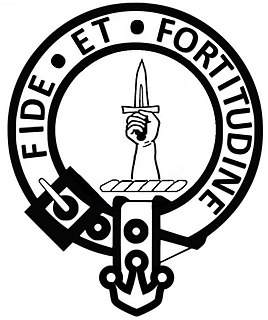
Clan Shaw is a Highland Scottish clan and is a member of the Chattan Confederation.

Clan Lyon is a Scottish clan.

Clan Rose is a Scottish clan of the Scottish Highlands.

Clan Carnegie is a Lowland Scottish clan

The Clan Hamilton, or House of Hamilton, is a Lowland Scottish clan.

Clan Maclachlan, also known as Clan Lachlan, Clann Lachainn (Argyll), and Clann Lachlainn, is a Highland Scottish clan that historically centred on the lands of Strathlachlan on Loch Fyne, Argyll on the west coast of Scotland. The clan claims descent from Lachlan Mor, who lived on Loch Fyne in the 13th century, and who has left his name upon the countryside he once controlled: places such as Strathlachlan, Castle Lachlan and Lachlan Bay. Tradition gives Lachlan Mor a descent from an Irish prince of the O'Neill dynasty, Ánrothán Ua Néill, son of Áed, son of Flaithbertach Ua Néill, King of Ailech and Cenél nEógain, died 1036. Clan Maclachlan has been associated with other clans, such as Clan Lamont, Clan Ewen of Otter, Clan MacNeil of Barra, and the MacSweens: as all claim descent from Anrothan O'Neill who left Ireland for Kintyre in the 11th century. From this descent the clan claims a further descent from the legendary Niall Noigíallach, High King of Ireland, who lived from the mid 4th century to the early 5th century.

Clan Moncreiffe is a Highland Scottish clan.

Clan Irvine is a Scottish clan.
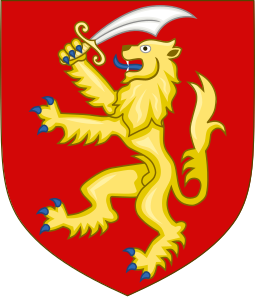
Clan Scrymgeour is a Highland Scottish clan.
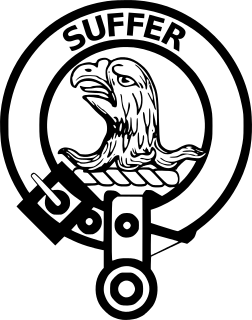
Clan Haldane is a Lowland Scottish clan.

Clan Makgill is a Lowland Scottish clan.

Clan MacAulay, also spelt Macaulay or Macauley is a Scottish clan. The clan was historically centred on the lands of Ardincaple, which are today consumed by the little village of Rhu and burgh of Helensburgh in Argyll and Bute. The MacAulays of Ardincaple were located mainly in the traditional county of Dunbartonshire, which straddles the "Highland Line" between the Scottish Highlands and Lowlands. Clan MacAulay has been considered a "Highland clan" by writers and has been linked by various historians to the original Earls of Lennox and in later times to Clan Gregor. The MacAulays of Ardincaple, like Clan Gregor and several other clans, have traditionally been considered one of the seven clans which make up Siol Alpin. This group of clans were said to have claimed descent from Cináed mac Ailpín, King of the Picts, from whom later kings of Scotland traced their descent. The chiefs of Clan MacAulay were styled Laird of Ardincaple.
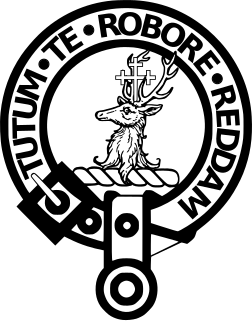
Clan Crawford is a lowland Scottish clan of Scandinavian and Anglo-Saxon origin. Since the early 18th century an erroneous belief was held by some historians that the clan had Norman origins, but this belief has been shown to be false and based on spurious comparisons of the arms of Crawford with those of the Earl of Richmond. While historically recognised as a clan by the Court of the Lord Lyon, it is now an armigerous clan as it no longer has a chief. The last chief was Hugh Ronald George Craufurd, who sold his land and moved to Canada in 1904. He died in Calgary in 1942, leaving no male heirs.
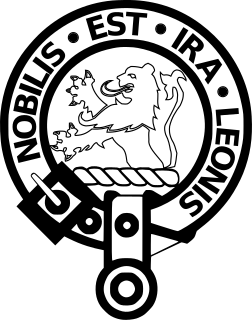
Clan Stuart of Bute is a Highland Scottish Clan and is a branch of the larger Clan Stewart.

Clan Forbes is a Highland Scottish clan from Aberdeenshire, Scotland.

Stewart of Balquhidder is a Perthshire branch of the Stewart clan and scions of the royal House of Stewart from an illegitimate branch. They are descended from Sir William Stewart of Baldorran, who was the great grandson of Murdoch Stewart, Duke of Albany, executed by King James I of Scotland for treason in 1425. Murdoch Stewart was himself the grandson of King Robert II of Scotland, who founded the Stewart dynasty.
Malcolm Maclean or Maolcaluim mac Giliosa in Scottish Gaelic, was the 3rd Chief of Clan Maclean. Malcolm's name has been written Maol-Calum and Gille-Calum, which means Servant of Columba. He became the Chief of Clan Maclean on the death of his father in 1300. He was succeeded by John Dubh Maclean, 4th Clan Chief, his youngest son, because the law of primogeniture did not apply in Scotland yet. He died around 1320.

William Stuart Stirling-Crawfurd (1819-1883) of Milton in Lanarkshire, Scotland, was a prominent racehorse owner.



















